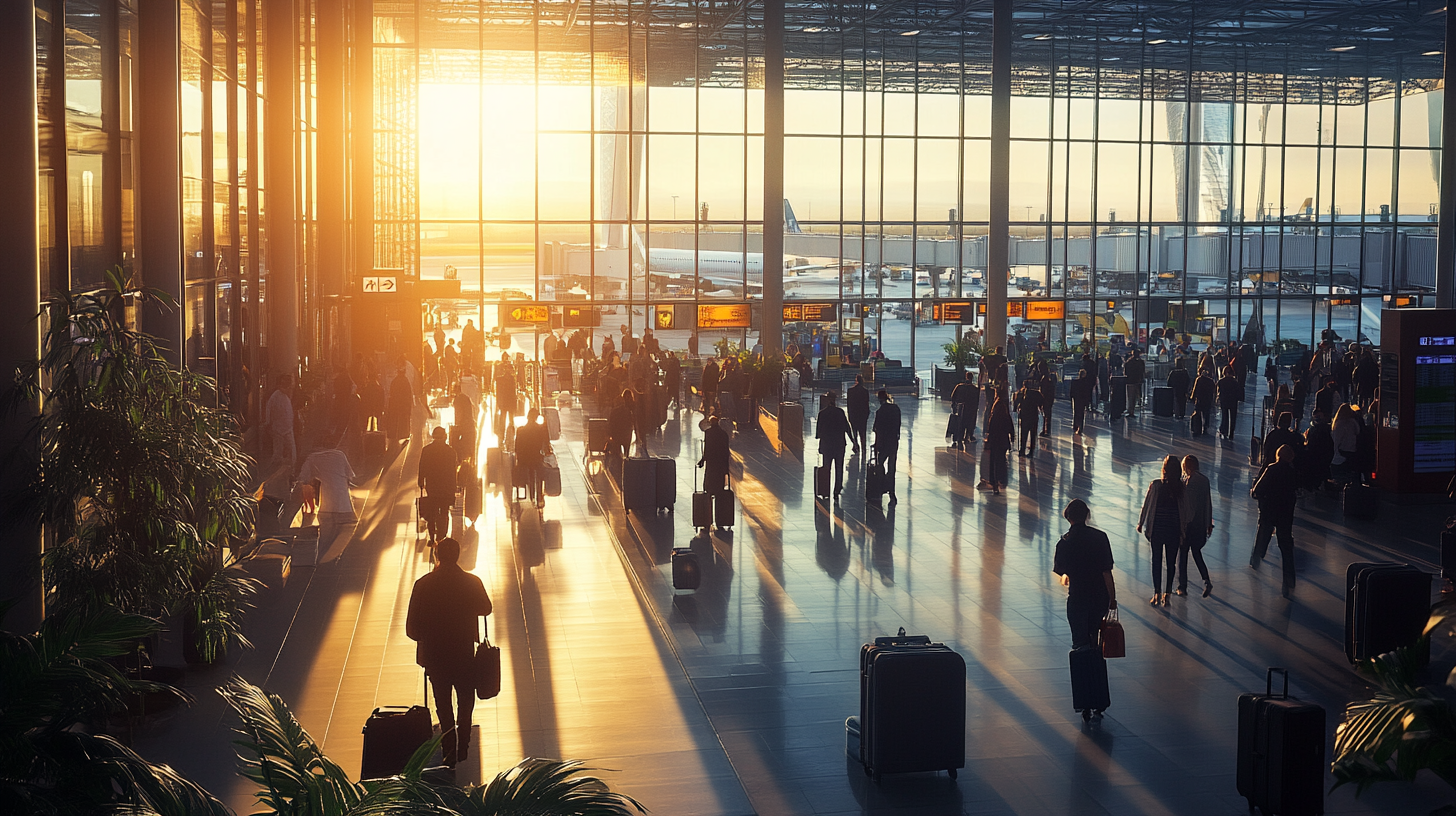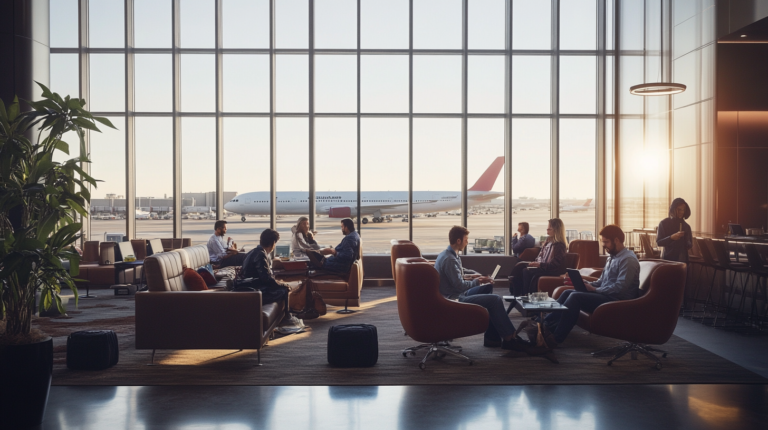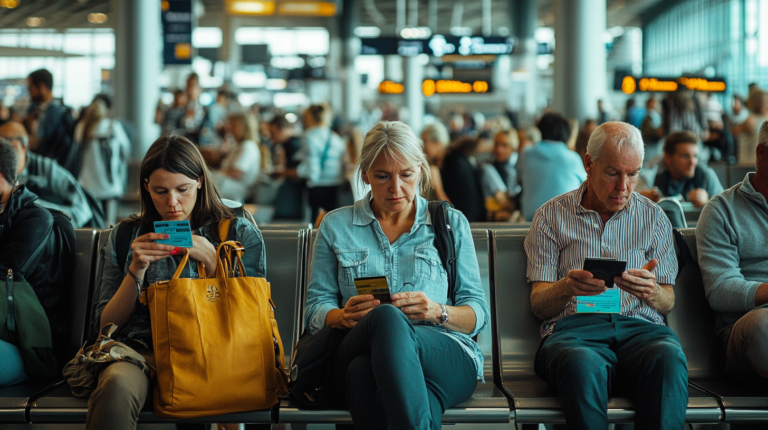Miles Ahead: Sustainable Business Travel Takes Off
Back when in-person events started making their post-pandemic comeback in 2023, I saw a whole new wave of business travel emerging, layered with fresh environmental and social responsibilities. From the hustle of green airports to the subtle art of flight offsetting, it felt as though our travel routines were finally aligning with sustainable ideals. This shift wasn’t just a buzzword in the boardroom but a genuine movement that shaped how we took to the skies—making every mile count for both productivity and the planet.
1. The Rebound of Business Travel

In 2023, I remember reading how 32% of consumers planned trips for professional and personal reasons, signaling a noticeable surge in business travel that began to echo patterns we hadn’t seen since before 2020. I’ve noticed that companies, eager to rekindle the magic of in-person engagement, started prioritizing direct flights to slash carbon emissions, choosing local vendors to support the communities we visit, and encouraging more eco-friendly ground transportation. By 2025, it’s become second nature for many organizations to weave green goals into their travel itineraries—no longer an afterthought but a focal point of every conference, client meeting, or project site visit.
According to a recent analysis by the Global Business Travel Association, business travel is set to climb another 20% by year’s end, bolstered by the desire to blend face-to-face collaboration with strategic sustainability. In my own travels, I’ve seen local tourism boards and convention centers jump on this trend, offering perks like discounted public transit passes or complimentary bicycle rentals to visiting professionals. It’s an inspiring reminder that, as we embrace the comeback of business travel, we can do so in a way that enriches both our work and the world around us.
I also recall how some of my colleagues combined multiple client meetings into a single trip—a tactic that not only saved time but also cut down on emissions from repeated flights. I believe it’s more than a cost-saving measure; it’s a mindset change that leaves a lighter footprint everywhere we go.
2. New Mandates and Transparent Procurement

By 2025, new reporting requirements, including measures in the EU’s Corporate Sustainability Reporting Directive (CSRD), have prompted businesses to be upfront about travel-related emissions. I’ve had to fill out more detailed sustainability reports for my own company this year than ever before, ensuring that each trip is accounted for and tied to a legitimate purpose. These mandates encourage greater scrutiny of suppliers and partners, from green hotels to eco-conscious airlines.
According to industry data from EcoVadis, more than half of corporate procurement teams now rate environmental disclosure as a top consideration when partnering with travel service providers. This heightened visibility places real pressure on all of us to pick suppliers who share in our eco-friendly mission—nothing says accountability quite like seeing your carbon numbers in black and white. In my experience, it also helps create more meaningful relationships with vendors committed to the same planet-first approach.
Beyond the metrics, transparency has shaped how we talk about sustainable travel in team meetings. I’ve seen procurement managers factor in community engagement, workforce diversity, and even fair labor practices. Sending folks on the road is no longer just about booking the cheapest flight or nearest hotel, but rather aligning with organizations that actively contribute to a healthier, more equitable world.
3. Greener Transportation Choices

As 2025 unfolds, I’ve been increasingly impressed by how businesses are doubling down on low-carbon transportation. Electric vehicle fleet rentals are becoming the standard option, and I’ve personally tried scenic routes on high-speed trains—both domestically and abroad. It’s not just about reducing our carbon footprint; it’s also a fantastic way to soak in local scenery and meet people outside of the usual airport lounge crowd.
A recent study by the International Council on Clean Transportation suggested that electric aircraft might become a reality within the next decade, spurring conversations about the future of flying as a more sustainable practice. While that milestone might still be years off, every step in the right direction—like airlines investing in sustainable aviation fuel—helps us get closer. I find that booking tools are constantly updating with greener route suggestions, making it easier for frequent travelers to plan efficient and eco-conscious journeys.
On a practical note, I’ve found that mixing up domestic travel itineraries—like taking a train from city to city—can open doors to seeing more of a region’s cultural and natural wonders. Whether I’m on my way to a conference or client session, it’s refreshing to discover new local flavors and traditions along the route, all while staying true to climate commitments.
4. Responsible Accommodations and Community Support

Many hotels have caught on to the fact that travelers expect more than just fresh linen—they want a genuinely responsible stay. In my journeys, I’ve seen everything from solar-paneled rooftops to onsite composting programs at boutique hotels. These innovations often save properties money in the long run, while reducing waste and energy consumption. When a hotel invests in sensible water usage or invests in local produce, I notice my own sense of responsibility elevating: It feels like every aspect of my trip is aligned with a greater good.
According to the Global Sustainable Tourism Council, properties that follow recognized sustainable guidelines show measurable reductions in energy usage and carbon output. Some of the upscale accommodations I’ve visited actually reinvest part of their earnings into local economic development, ensuring that every guest stay contributes to grassroots initiatives. It’s profoundly rewarding to see genuine intention behind the concept of leaving a positive impact wherever we go.
Meanwhile, philanthropy programs—such as the ones offered by Abercrombie & Kent‘s philanthropy arm (AKP)—illustrate how travel can directly uplift communities. I once visited a humanitarian project during a work trip, and it completely changed how I viewed the value of each business journey. Simply put, by choosing properties and operators that keep sustainability at the forefront, I know I’m making every travel dollar work harder for the planet and its people.
5. High-Tech Tracking and Carbon Offsets

Another trend that’s caught my attention is how AI-driven data tools have made emissions tracking almost effortless. It’s surprisingly easy these days to see the carbon cost of each flight segment or hotel stay in real time. My company uses a platform that integrates offset options directly into the booking process, so I can check a box and contribute to a verified reforestation or clean-energy project. It’s reassuring to know exactly where those funds are going and how they help neutralize the environmental toll of my travels.
Many corporate travel programs now encourage us to set carbon budgets—much like the financial kind—to foster more mindful decision-making. A recent article in the Journal of Sustainable Tourism underscored that carbon budgeting can drive innovative employee behavior, from choosing eco-lodging to holding virtual meetings even when a quick flight could be arranged. While offsets aren’t a silver bullet, they help bridge the gap for those trips that are unavoidable.
In some cases, I’ve also seen free online resources that teach teams how to systematically reduce travel-related emissions, though signing up often requires sharing organizational data. The more transparent we are with our own travel stats, the better these tools can tailor solutions, making it an all-around win for efficiency and the environment.
The Bottom Line for Frequent Flyers

For frequent flyers like me, sustainable business travel is now a balancing act between efficiency and eco-responsibility. I still value a nonstop route to save precious hours, yet I’ve grown more conscious about offsetting or selecting an airline that invests in sustainable aviation fuel. From hotels that run on solar power to management firms like Worldgo and eco-certified housing platforms such as AltoVita, there’s no shortage of options if I want to green up my routine.
I’ve realized that it’s easier than ever to combine productivity with responsible travel, thanks to an evolving industry that offers choices at every turn. Opting for the right kind of flights, accommodations, and local experiences preserves the best of business travel while minimizing environmental and social costs. That’s a future I can definitely get behind.
Final Thoughts

Sustainable business travel is evolving faster than I ever imagined, and it’s thrilling to see this transformation in real time. From the moment we plan a trip—keeping carbon budgets in mind—to the follow-up report that tracks every flight segment, each detail now contributes to a more conscientious travel ecosystem. As 2025 continues, I believe these adjustments and insights will push us toward an era where our journeys are both purposeful and planet-positive.
We may never completely abandon the thrill of a face-to-face meeting or the satisfaction of sealing a deal with a handshake, but we can certainly refine how we get there. Every traveler, procurement officer, and supplier is stepping up to the plate, understanding that sustainability isn’t just a catchphrase. It’s a responsibility for all of us, shaping the outlook of business travel one booking at a time.
Big-picture changes—like industry-wide mandates and greener transportation—are paving the way for a future in which the skies remain welcoming and vibrant for generations to come. It’s a hopeful sign that business travel can continue to bring people together, all while honoring our shared commitment to the environment.
Barry B.’s Take
The way I see it, each one of us is a piece of this massive puzzle called global mobility, and our collective choices genuinely matter. I’m always amazed at how quickly technology and policy have stepped up to this challenge, enabling even the most road-weary traveler to find greener ways to rack up miles. Every meeting, every city, every flight comes with a chance to do better than before.
For me, the real thrill of travel lies in connecting with the people and communities I encounter along the way. If our journeys can leave a lasting, positive impact—whether through lower emissions or direct community support—then we’re on the right path. It’s about enjoying the ride and making it count.







